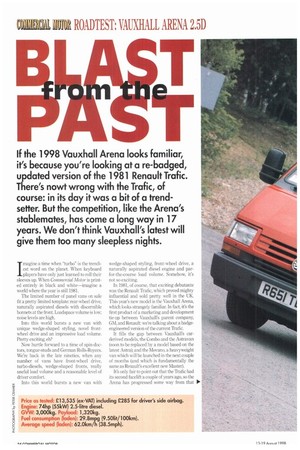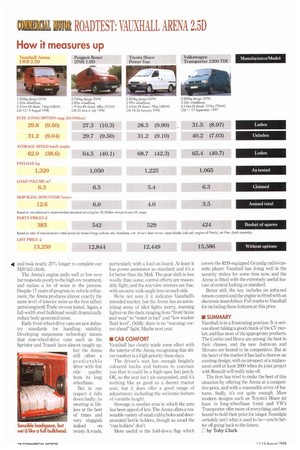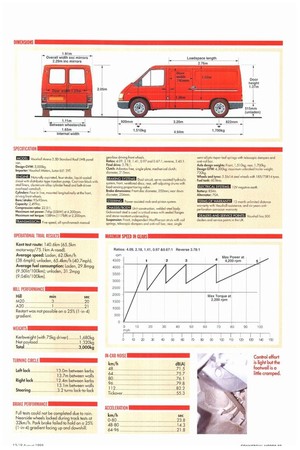ROADTEST: VAUXHALL ARENA 15D
Page 26

Page 28

Page 30

Page 29

If you've noticed an error in this article please click here to report it so we can fix it.
if the 1998 Vauxhall Arena looks familiar, it's because you're looking at a re-badged, updated version of the 1981 Renault Trafic. There's nowt wrong with the Trafic, of course: in its day it was a bit of a trendsetter. But the competition, like the Arena's stablemates, has come a long way in 17 years. We don't think Vauxhall's latest will give them too many sleepless nights.
/magine a time when "turbo" is the trendiest word on the planet. When keyboard players have only just learned to roll their sleeves up. When Commercial Motor is printed entirely in black and white—imagine a world where the year is still 1981.
The limited number of panel vans on sale fit a pretty limited template: rear-wheel drive, naturally aspirated diesels with discernible bonnets at the front. Loadspace volume is low; noise levels are high.
Into this world bursts a new van with unique wedge-shaped styling, novel frontwheel drive and an impressive load volume. Pretty exciting, eh?
Now hurtle forward to a time of spin-doctors, tongue-studs and German Rolls-Royces. We're back in the late nineties, when any number of vans have front-wheel drive, turbo-diesels, wedge-shaped fronts, really useful load volume and a reasonable level of driver comfort.
Into this world bursts a new van with wedge-shaped styling, front-wheel drive, a naturally aspirated diesel engine and parfor-the-course load volume. Somehow, it's not so exciting.
In 1981, of course, that exciting debutante was the Renault Trafic, which proved mighty influential and sold pretty well in the UK. This year's new model is the Vauxhall Arena, which looks strangely familiar. In fact, it's the first product of a marketing and development tie-up between Vauxhall's parent company, GM, and Renault: we're talking about a badgeengineered version of the current Trafic.
It fills the gap between Vauxhall's carderived models, the Combo and the Astravan (soon to be replaced by a model based on the latest Astra); and the Movano, a heavyweight van which will be launched in the next couple of months (and which is fundamentally the same as Renault's excellent new Master).
It's only fair to point out that the Trafic had its second facelift a couple of years ago, so the Arena has progressed some way from that I*
.4 1981 van. But
Vauxhall's last main: stream panel van, the Midi, was itself based on an ageing Isuzu design and was widely thought of as mediocre; hardly a worthy successor to the well-regarded Bedford CV So is the Arena simply a gap-filler designed to show that Vauxhall can offer a complete range of vans, or is it a viable model in its own right?
• PRODUCT PROFILE Vauxhall is sensibly not trying to match Ford, with its seemingly limitless range of Transit variants and options. Instead, the company is offering just three versions of the Arena: a short-wheelbase van and standard-roof or high-roof long-wheelbase vans. For short. wheelbase read 2.80m; the longer wheelbase measures 3.20m.
Naturally aspirated diesels are fitted all round. The SWB van gets a 59hp (44kW) 1.9-litre unit, while the I,WB versions have a 74hp (55kW) 2.5-litre engine. Both engines are sourced via Renault, though the larger diesel is fundamentally the same 2.5-litre SOFIMbuilt unit that has powered the Fiat Ducat° as well as the Trafic.
The 1.90 Standard Roof model, with a load volume of 5.3m, has a base price of .0,995. The 2.50 LWI3 Standard Roof (load volume: 6.3m3) costs 1:13,250; while the 2.50 LWB High Roof (load volume: 7.8m3) will set you back £14,075. To these prices you can add £446 (ex-AAT) for delivery and number plates, plus the cost of your road fund licence.
Factory-fitted options are strictly limited too: there's only a driver's-side airbag for .C285 and a dual passenger seat with a full-height glazed bulkhead—a more obvious choice at £170. Vinyl seat trim is a no-cost option, and there are just three standard body colours: Enamel White (there's a surprise), Signal Red or Aqua Blue.
Dealer-fitted options and accessories are more plentiful, ranging from a substantial roof rack to an anti-slip loadspace mat, headlamp protectors, a fire extinguisher and a towbar kit. The 2.5-litre engine is an overhead-cam indirect-injection diesel with few remarkable features. Rather slyly, Vauxhall mentions 10,000-mile service intervals in its van brochure. The small print reveals that "an additional oil change is required every 5,000 miles" So that's all right, then.
• PRODUCTIVITY The Arena's engine might not be the last word in diesel engine technology, but it returns pretty fair fuel consumption. Our fully laden figure round the Rent route was just a hair below 30mpg, and within a couple of mpg of rivals in the 2.8-tonne GVW class such as the Volkswagen Transporter 1200TDI, the Peugeot Boxer 2708 and the Toyota Hiace Power Van. Average speed was a little down too, but in practice this only matters if you do a lot of arduous motorway runs.
In fact, those 2.8-tonners are the obvious rivals for the Arena. They generally offer a little less payload and a similar load volume (you won't find much more until you go up to 3.5 tonnes) but the price is around the same.
The Arena's payload is pretty good at a true 1.3 tonnes with a fair 210kg of axle load tolerance. When theahem—Trafic was first introduced we were deeply impressed by the size and convenience of its loadspace and the low loading height afforded by frontwheel drive, Nowa. days the Arena's 6.3m3 of load volume and loading height are less notable, but they still haven't been beaten by many. Only the wide, square Sevel vans (the Fiat Ducato,
Peugeot Boxer and Citroen Relay), with their full-height side loading doors, are obviously better in this respect.
The Vauxhall's 745mm-wide side loading door has been outclassed by more modern designs which will allow a Europallet to pass. However, the space between the wheelarches is a very useful 1,106min; the interior height is over 1.5m; and the rear loading doors can fold back through better than 180P. Its a shame, though, that the spare wheel takes up some of the loadspace.
It's not clear from Vauxhall's literature if the Arena's load volume figure has been measured according to the optimistic SAE method or the more realistic VDA technique, but the load space looks pretty useful so our guess is that the figure is VDA.
The bulkhead, such as it is, is less impressive. It comprises no more than a vertical bar and a mesh grille behind the driver's seat, so passengers will have to take their chances if loads start to fly around. We would always opt for a solid, full-width bulkhead for the sake of safety as well as noise reduction, Still, Vauxhall's arrangement allows you to fold the back of the dual passenger seat forward, increasing load length by the best part of a metre—useful for solo carpet-fitters, perhaps?
• ON THE ROAD With just 74hp from the engine you wouldn't expect stunning performance, but the Arena doesn't feel t(x) sluggish. Its horses are backed up by a torque curve which peaks at just 2,200rpm (though there's no rev-counter to let you know that) and it manages to pull rather higher gearing than most of its competitors.
This will be good for fuel consumption (given a careful driver), but it's hardly conducive to good acceleration. In the event the Vauxhall's 0-80km/h time was almost embarrassing. It was a full lOsec slower than that of the 101hp Volkswagen Transporter TD 111. 44 and took nearly 25% longer to complete our M20 hill climb.
The Arena's engine pulls well at low revs but responds poorly to the high-rev treatment, and makes a lot of noise in the process. Despite 17 years of progress in vehicle refinement, the Arena produces almost exactly the same level of interior noise as the first (albeit petrol-engined) Trafic we ever tested. Again, a full-width steel bulkhead would dramatically reduce body-generated noise.
Early front-wheel-drive vans set new indus try standards for handling stability.
Developing suspension technology means that rear-wheel-drive vans such as the Sprinter and Transit have almost caught up, but the Arena still offers a predictable drive with fair ride quality from its long wheelbase.
But in one respect it falls down badly: its steering is lifeless at the best of times and very sluggish indeed on twisty A-roads, particularly with a load on board. At least it has power assistance as standard; and it's a lot better than the Midi. The gear shift is less woolly than some; control efforts are reasonably light; and the rearview mirrors are fine, with an extra wide-angle lens on each side.
We're not sure if it indicates Vauxhall's intended market, but the Arena has an astonishing array of idiot lights (sorry, warning lights) on the dash, ranging from "front brake pad wear" to "water in fuel" and "low washer fluid level". Oddly, there is no "warning; corner ahead" light. Maybe next year.
• CAB COMFORT Vauxhall has clearly made some effort with the interior of the Arena, recognising that driver comfort is a high priority these days.
The driver's seat has enough brightly coloured knobs and buttons to convince you that it could be a high-spec Isri perch. OK, so the seat isn't air-suspended, and it's nothing like as good as a decent tractor seat, but it does offer a good range of adjustment, including the welcome feature of variable height.
Stowage is another area in which the ante has been upped of late. The Arena offers a reasonable variety of small cubbyholes and doormounted bottle holders, though as usual the "cup holders" don't.
More useful is the fold-down flap which covers the RDS-equipped Grundig radio/cassette player. Vauxhall has doing well in the security stakes for some time now, and the Arena is fitted with the extremely useful feature of central locking as standard.
Better still, the key includes an infra-red remote control and the engine is fitted with an electronic immobiliser. Full marks to Vauxhall for including these features at this price.
• SUMMARY
Vauxhall is in a frustrating position. It is serious about taking a good chunk of the CV market, and has most of the appropriate products. The Combo and Brava are among the best in their classes, and the new Astravan and Movano are bound to be competitive. But in the heart of the market it has had to borrow an existing design, with no prospect of a replacement until at least 2000 when its joint project with Renault will really take off.
The firm has tried to make the best of this situation by offering the Arena at a competitive price, and with a reasonable array of features. Sadly, it's not quite enough. More modern designs such as Toyota's Hiace (at least in long-wheelbase form) and VIArs Transporter offer more of everything, and are bound to hold their price for longer. Nostalgia
certainly isn't what it used to be you're better off going back to the future. by Toby Clark
Price as tested: £13,535 (ex-VAT) including £285 for driver's side airbag.
Engine: 74hp (55kW) 2.5-litre diesel. GVW: 3,000kg. Payload: 1,320kg.
Fuel consumption (laden): 29.8mpg (93014/100km). Average speed (laden): 62.0km/h138.5mph). SPECIFICATION
ISM Vauxhall Arena 2.50 Standard Roof tWB panel van. Design GVW: 3,000kg
Importer: Vauxhall Motors, Luton LU I 3Y1'.
MEI Naturally aspirated, four-stroke, liquid-cooled diesel with distributor-type injection pump. Cost-iron block with steel liners, aluminium-alloy cylinder head and belt-driven overhead camshaft. Cylinders: Four in line, mounted longtivdnally at the front, driving front wheels.
Bore/stroke: 93x92mm.
Capocity: 2,499cc.
Compression ratio: 22.0:1.
Maximum net power: 74hp (55kW) at 4,200rprn. Maximum net torque: 158Nm (1171bft) at 2,200rpm.
REEMEIMI Five-speed, all-synchromesh manual
gearbox driving front wheels.
Ratios: 4.09,2.18, 1.41,0.97 and 0.67:1; reverse, 3.45:1. Final drive: 3.78:1. Clutch: Asbestos-free, single-plate, mechanical clutch; diameter, 215min.
Dual-circuit, servo-assisted hydraulic system; front, ventilated discs; rear, self-adjusting drums with load-sensing proportioning valve.
BRAKING SYSTEMS:
Brake dimensions: Front disc dameter, 252mm; rear drum diameter, 254rnm.
EIBMEI Power-assisted rock-and-pinion system.
EMEENNEM Unit-construction, welded-steel body. Galvanised steel is used in critical areas with sealed flanges and stone-resistant undersealing. Suspension: Front, independent MacPherson shuts with coil springs, telescopic dampers and anti-roll bar, rear, single
semi-elliptic taper-leaf springs with telescopic dampers and anti-roll bor.
Axle design weights: Front, 1,510kg, rear, 1,700kg. Design GTW: 4,300kg; Maximum unbraked trailer weight, 730kg.
Wheels and tyres: 5.5Jx14 steel wheels with 185/75R14 tyres Fuel tank: 40 litres
InnECIMENEM 12V negative-earth. Battery: 85Ah.
Alternator: 704.
TERMS OF WARRANTY:
2-month unlimited-distance
warranty with Vauxhall assistance, and six-years antiperforation corrosion warranty
DEALERS AND SERVICE POINTS. Vauxhall has 500 dealers and service points in the UK
OPERATIONAL TRIAL RESULTS Kent test route: 140.6km (65.5km motorway/75.1km A-road).
Average speed: Laden, 62.0km/h (38.6mph); unladen, 65.4km/h (40.7mph). Average fuel consumption: Laden, 29.8mpg (9.501it/100km); unladen, 31.2mpg (9.0414/100km).
HILL PERFORMANCE Hill min sec M20 3 20 A20 1 21 Restart was not possible on a 25% (1-in-4) gradient.
WEIGHTS Kerbweight (with 75kg driver) 1,680kg Net payload 1,320kg Total 3,000kg
TURNING CIRCLE
Left lock 13.0m between kerbs 13.7m between walls Right lock 12.4m between kerbs 13.1m between walls Steering 3.2 turns lock-to-lock BRAKE PERFORMANCE Full tests could not be completed due to rain. Nearside wheels locked during track tests at 32km/h. Park brake failed to hold on a 25% (1-in-4) gradient facing up and downhill. IN-CAB NOISE km/h dB(A) 48 71.5 64 75.7 80 76.1 96 79.8 112 82.2 Tickover 55.3 ACCELERATION km/h sec 0-80 23.8 48-80 14.3 64-96 21.8




































































































